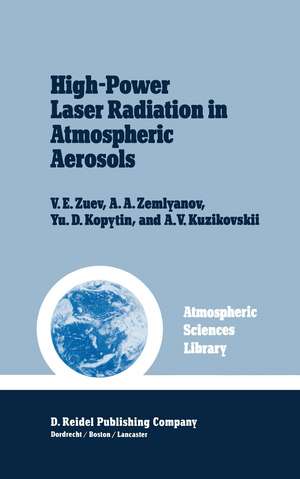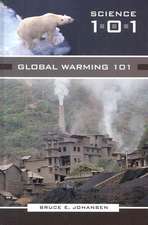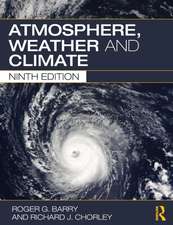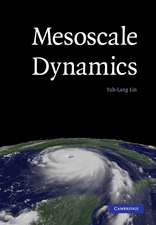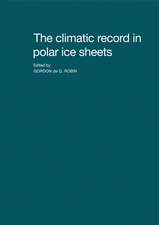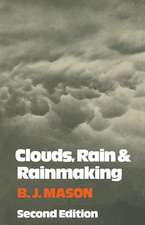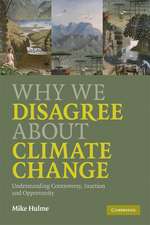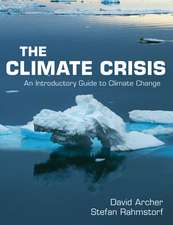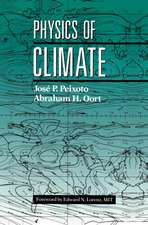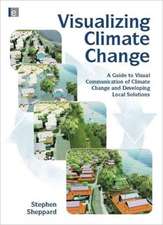High-Power Laser Radiation in Atmospheric Aerosols: Nonlinear Optics of Aerodispersed Media: Atmospheric and Oceanographic Sciences Library, cartea 4
Autor V.E. Zuev Traducere de Yu.F. Arshinov Autor A.A. Zemlyanov, Yu.D. Kopytin, A.V. Kuzikovskiien Limba Engleză Hardback – 30 iun 1985
| Toate formatele și edițiile | Preț | Express |
|---|---|---|
| Paperback (1) | 945.14 lei 6-8 săpt. | |
| SPRINGER NETHERLANDS – 19 oct 2011 | 945.14 lei 6-8 săpt. | |
| Hardback (1) | 951.29 lei 6-8 săpt. | |
| SPRINGER NETHERLANDS – 30 iun 1985 | 951.29 lei 6-8 săpt. |
Din seria Atmospheric and Oceanographic Sciences Library
- 18%
 Preț: 1996.98 lei
Preț: 1996.98 lei - 18%
 Preț: 957.75 lei
Preț: 957.75 lei - 18%
 Preț: 963.15 lei
Preț: 963.15 lei - 18%
 Preț: 1156.64 lei
Preț: 1156.64 lei - 18%
 Preț: 948.61 lei
Preț: 948.61 lei - 18%
 Preț: 946.55 lei
Preț: 946.55 lei - 18%
 Preț: 1224.18 lei
Preț: 1224.18 lei - 18%
 Preț: 1226.90 lei
Preț: 1226.90 lei - 18%
 Preț: 952.26 lei
Preț: 952.26 lei - 15%
 Preț: 639.90 lei
Preț: 639.90 lei - 18%
 Preț: 1229.58 lei
Preț: 1229.58 lei - 18%
 Preț: 1418.98 lei
Preț: 1418.98 lei - 18%
 Preț: 950.66 lei
Preț: 950.66 lei - 24%
 Preț: 801.40 lei
Preț: 801.40 lei - 18%
 Preț: 1237.30 lei
Preț: 1237.30 lei - 18%
 Preț: 1225.79 lei
Preț: 1225.79 lei - 18%
 Preț: 960.42 lei
Preț: 960.42 lei - 18%
 Preț: 1392.46 lei
Preț: 1392.46 lei - 18%
 Preț: 947.18 lei
Preț: 947.18 lei - 18%
 Preț: 1235.76 lei
Preț: 1235.76 lei - 18%
 Preț: 1541.47 lei
Preț: 1541.47 lei - 18%
 Preț: 1390.59 lei
Preț: 1390.59 lei - 18%
 Preț: 1226.73 lei
Preț: 1226.73 lei - 18%
 Preț: 974.67 lei
Preț: 974.67 lei - 18%
 Preț: 952.40 lei
Preț: 952.40 lei - 18%
 Preț: 954.45 lei
Preț: 954.45 lei -
 Preț: 390.25 lei
Preț: 390.25 lei - 20%
 Preț: 585.98 lei
Preț: 585.98 lei
Preț: 951.29 lei
Preț vechi: 1160.10 lei
-18% Nou
Puncte Express: 1427
Preț estimativ în valută:
182.09€ • 197.85$ • 153.05£
182.09€ • 197.85$ • 153.05£
Carte tipărită la comandă
Livrare economică 21 aprilie-05 mai
Preluare comenzi: 021 569.72.76
Specificații
ISBN-13: 9789027717368
ISBN-10: 9027717362
Pagini: 310
Ilustrații: XIV, 292 p.
Dimensiuni: 155 x 235 x 22 mm
Greutate: 0.61 kg
Ediția:1985
Editura: SPRINGER NETHERLANDS
Colecția Springer
Seria Atmospheric and Oceanographic Sciences Library
Locul publicării:Dordrecht, Netherlands
ISBN-10: 9027717362
Pagini: 310
Ilustrații: XIV, 292 p.
Dimensiuni: 155 x 235 x 22 mm
Greutate: 0.61 kg
Ediția:1985
Editura: SPRINGER NETHERLANDS
Colecția Springer
Seria Atmospheric and Oceanographic Sciences Library
Locul publicării:Dordrecht, Netherlands
Public țintă
ResearchCuprins
1: Microphysical and Optical Characteristics of Atmospheric Aerosols.- 1.1. Introduction.- 1.2. Preliminary Discussion.- 1.3. Light Scattering by Clouds and Fogs.- 1.4. Light Scattering by Hazes.- 1.5. Microphysical and Optical Characteristics of Precipitation.- 1.6. Scattering Phase Functions of Polydispersed Aerosols.- References: Chapter 1.- 2: Low-Energy (Subexplosive) Effects of Radiation on Individual Particles.- 2.1. Regular Regimes of Droplet Vaporization in the Radiation Field.- 2.2. Vaporization of Haze Particles Consisting of a Solid Nucleus and a Shell of Salt in Solution.- 2.3. Some Peculiarities in the Vaporization of Solid Aerosol Particles by High-Power Radiation.- 2.4. Burning of Carbon Aerosol Particles in a Laser Beam.- 2.5. Initiation of Droplet Surface Vibrations by Laser Radiation.- References: Chapter 2.- 3: The Formation of Clear Zones in Clouds and Fogs Due to the Vaporization of Droplets under Regular Regimes.- 3.1. Basic Characteristics of the Process of Clearing a ‘Frozen’ Cloud.- 3.2. Stationary Cleared Channels in Moving Clouds.- 3.3. The Unstable Regime of Moving Cloud Clearance.- 3.4. The Determination of the Parameters of the Cleared Zone Taking into Account the Angular Beam Width and Wind Speed.- 3.5. The Generalized Formula Describing the Beam Intensity in the Process of Beam-Induced Clearing.- 3.6. The Cleared Channel under Conditions of Turbulent Aerosol Transport.- 3.7. Nonlinear Extinction Coefficient of Aerosols.- 3.8. The Investigation of Beam-Induced Clearing of Natural Fogs.- References: Chapter 3.- 4: Self-Action of a Wave Beam in a Water Aerosol under Conditions of Regular Droplet Vaporization.- 4.1. Basic Equations of Wave Beam Self-action in a Discrete Scattering Medium.- 4.2. The Field of the Effective ComplexDielectric Constant of the Aerosol (within the Beam).- 4.3. Description of the Mean Intensity of a Beam.- 4.4. The Influence of Thermal Distortions of Wave Beams and Fluctuations of the Medium on the Beam-Induced Dissipation of Water Aerosols.- References: Chapter 4.- 5: Laser Beam Propagation through an Explosively Evaporating Water-Droplet Aerosol.- 5.1. Droplet Explosion Initiated by High-Power Laser Radiation.- 5.2. Droplet Explosion Regimes.- 5.3. Attenuation of Light by an Exploding Droplet.- References: Chapter 5.- 6: Propagation of High-Power Laser Radiation through Hazes.- 6.1. Nonlinear Optical Effects in Hazes: Classification and Features.- 6.2. Nonlinear Scattering of Light by Thermal Aureoles around Light-Absorbing Particles.- 6.3. Thermal Self-Action of a High-Power Laser Pulse Propagating through Dusty Hazes.- 6.4. Laser Radiation Transfer in Combustible Aerosols.- 6.5. Thermal Blooming of the cw and Quasi-cw Laser Beams due to Light Absorption by Atmospheric Aerosols and Gases.- References: Chapter 6.- 7: Ionization and Optical Breakdown in Aerosol Media.- 7.1. Physical and Mathematical Formulations of the Problem.- 7.2. Theoretical Analysis of Pulsed Optical Breakdown on Solid Aerosol Particles.- 7.3. The Influence of Atmospheric Turbulence on the Concentration of Optical Breakdown Centers.- 7.4. Laboratory Experiments on Laser Sparking.- 7.5. Optical Breakdown of Water Aerosols.- 7.6. Field Experiments on the Nonlinear Energetic Attenuation of Pulsed CO2-Laser Radiation during the Optical Breakdown of the Atmosphere.- References: Chapter 7.- 8: Laser Monitoring of a Turbid Atmosphere Using Nonlinear Effects.- 8.1. Brief Description of the Problem.- 8.2. Distortions of Lidar Returns caused by the Nonlinear Effects of the Interaction of High-Power LaserRadiation with Aerosols.- 8.3. An Analysis of the Criteria for Detecting a High-Power Laser Beam in Fog when the Beam Power is Sufficient to Dissipate the Fog.- 8.4. Remote Spectrochemical Analysis of Aerosol Composition using the Emission and Luminescent Spectra Induced by High-Power Laser Beams.- 8.5. An Analysis of the Possibilities of Sensing the High-Power Laser Beam Channel using Opto-Acoustic Techniques.- References: Chapter 8.- Index of Subjects.
